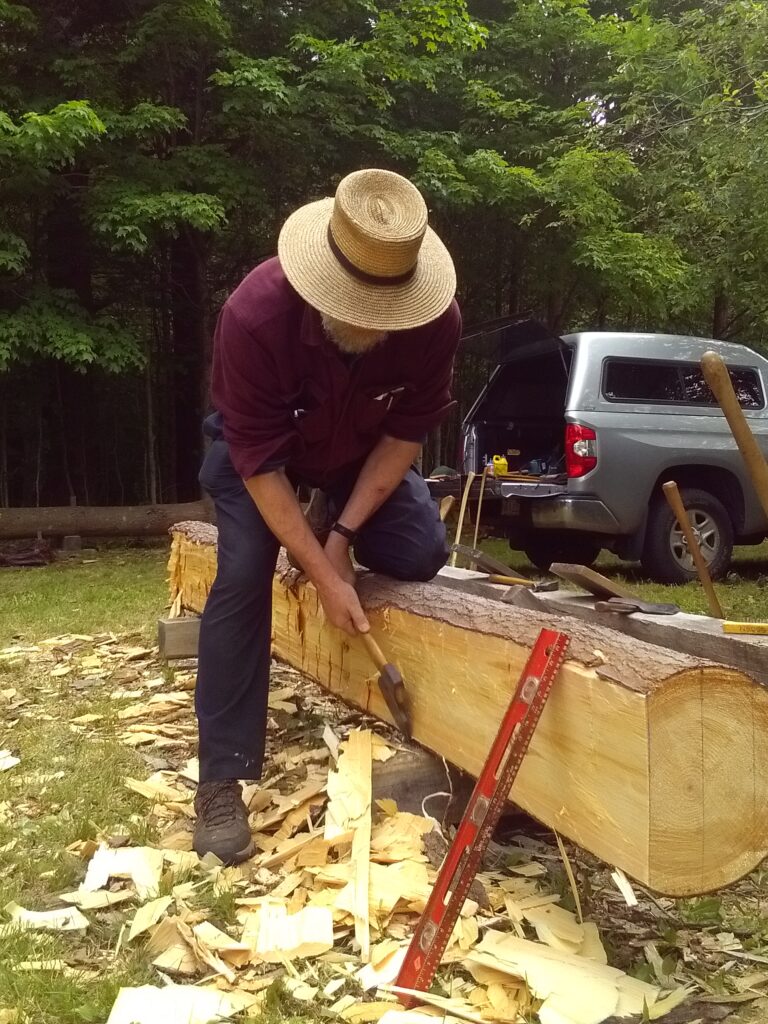I recently returned from a week-long timber conversion class in Massachusetts with the Timber Framers’ Guild, investigating different ways of harvesting and processing timbers for the buildings on St. Dunstan’s campus. It was one of the most demanding and memorable weeks of my working life. Felling trees, extracting them from the timber stand with a team of oxen, working on a portable saw-mill– each segment of the harvesting process required careful attention and coordination with the rest of the group.
The greatest challenge was converting a 14-foot-long pine log into a 9’’x11’’ hand-hewn timber. I’ve been around mills before and have worked with dozens of timbers of different species over the last few years, but this is the closest my hands have been to the process of turning trees into workable building materials.
Hand-crafting a timber requires a combination of skill and strength. The tools involved are simple but must be properly forged, cared for, and honed for their respective tasks. The challenge of using simple hand-tools to create square, smooth timbers both humbled and inspired me.

The first step of hand-hewing involves carefully laying out lines down the end of the timber-to-be using a level and a pencil. The plumb lines drawn on the end of the log are transferred down the length of the tree using a chalk-line. Once lines are established, the hewer climbs atop the log, balances himself, and gets to work cutting a series of V-shaped notches 16 or so inches apart from the butt-end of the log up to the top using a long-handled felling axe. The wood in between, known as the “juggles,” is knocked off with clean strokes taken down the grain of the wood. The remaining material is scored to the line at roughly 45 degrees with a felling axe.
Once the log has been juggled and scored, the hewer switches tools, trading the long-handled felling axe for a short-handled, heavy-headed broad axe, designed for paring rather than chopping. I’ve never worked with a broad axe before, but it is now one of my favorite hand tools. In order to hew effectively while minimizing strain on the body, the hewer positions himself down the length of the log with one knee at the top and one foot cocked out to the side and on the ground for balance. The work proceeds from the top of the log down to the butt end while the broad-axeman shaves and smooths the remaining wood until there is a flush, flat, lightly scalloped face. The only tools required for this stage are the broad axe and a level to check for plumb from time to time. After the first face is finished, the process is repeated on the parallel face. The timber is rotated after two faces are hewn, and the hewer works his way down the final two sides.
I have been back in Virginia for close to a week, and the blisters on my palms have mostly healed. The same is true of my knuckles, which I banged several times against the gnarly pine bark, so focused was I on achieving a smooth timber. There’s no easy way around the scrapes. Even with proper technique, which I acquired slowly throughout the hewing process, the task is strenuous and demanding. There were real moments of frustration. I had a grumbling voice in the back of my mind whisper something about there being a reason for modern technology, suggesting that I stand up, put down the axe, and find some machine better suited for the task.

Fortunately, I didn’t heed the voice’s suggestion. The second face I hewed was much smoother than the first. After several hours of practice, adjustment, and growth in confidence, the third face went much quicker than the first two. In his excellent work on the Cardinal Virtues, Josef Pieper writes, “to be patient means to preserve cheerfulness and serenity of mind in spite of injuries that result from the realization of the good.” Hand-hewing requires an unusual amount of sustained attention. But if it is not abandoned in a fit of frustration, this difficult work transforms the human person and the natural world by creating both a beautiful product that cannot be replicated by a machine and by nurturing the growth of an inner faculty that simply will not grow any other way.

My experience working up a timber with a set of axes brought to mind Gerard Manley Hopkins’s sonnet, “Patience,” which beautifully displays the connection between strain and patience, hardship and endurance:
“Patience” by Gerard Manley Hopkins
Patience, hard thing! the hard thing but to pray,
But bid for, Patience is! Patience who asks
Wants war, wants wounds; weary his times, his tasks;
To do without, take tosses, and obey.
Rare patience roots in these, and, these away,
Nowhere. Natural heart’s ivy, Patience masks
Our ruins of wrecked past purpose. There she basks
Purple eyes and seas of liquid leaves all day.
We hear our hearts grate on themselves: it kills
To bruise them dearer. Yet the rebellious wills
Of us we do bid God bend to him even so.
And where is he who more and more distils
Delicious kindness?—He is patient. Patience fills
His crisp combs, and that comes those ways we know.






